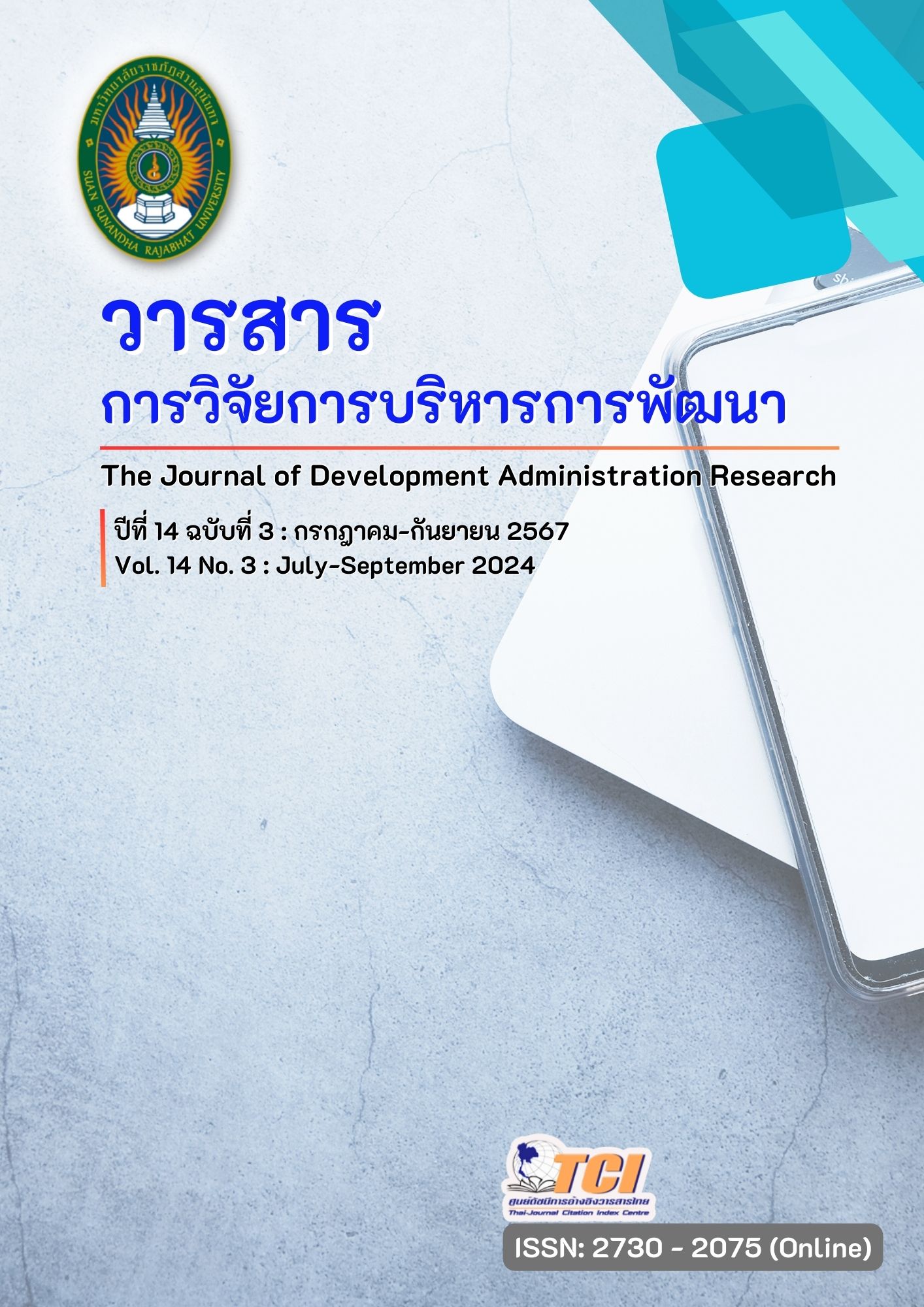บทบาทคั่นกลางของความได้เปรียบทางการแข่งขันและการกำกับทรัพยากรองค์การ อายุของกิจการ ที่เชื่อมโยงการมุ่งเน้นการตลาด นวัตกรรม ไปสู่ผลการดำเนินงานของธุรกิจบริการด้านสุขภาพและความงามในประเทศไทย
คำสำคัญ:
การมุ่งเน้นการตลาด, นวัตกรรม, ความได้เปรียบทางการแข่งขัน, ผลการดำเนินงานของธุรกิจบทคัดย่อ
การศึกษานี้มีวัตถุประสงค์เพื่อ 1) เพื่อศึกษาระดับความสำคัญของการมุ่งเน้นการตลาด นวัตกรรมความได้เปรียบทางการแข่งขัน ผลการดำเนินงานของธุรกิจบริการด้านสุขภาพและความงาม 2) เพื่อศึกษาอิทธิพลของการมุ่งเน้นการตลาด นวัตกรรม ความได้เปรียบทางการแข่งขันที่มีต่อผลการดำเนินงานของธุรกิจ
โดยการศึกษาครั้งนี้เก็บรวบรวมข้อมูลด้วยการแจกแบบสอบถามทางไปรษณีย์และแบบสอบถามออนไลน์กับผู้บริหารหรือเจ้าของธุรกิจบริการด้านสุขภาพและความงาม จำนวน 340 ตัวอย่าง สถิติที่ใช้ในการวิจัย คือ สถิติเชิงพรรณนา และการประเมินโมเดลเชิงโครงสร้าง
ผลการศึกษา พบว่า 1) ระดับความสำคัญของการมุ่งเน้นการตลาด นวัตกรรม ความได้เปรียบทางการแข่งขันอยู่ในระดับมาก ระดับความสำคัญของทรัพยากรที่องค์กรใช้เพื่อสร้างความได้เปรียบทางการแข่งขันและผลการดำเนินงานของธุรกิจอยู่ในระดับมากที่สุด 2) การศึกษาอิทธิพลของการมุ่งเน้นการตลาด นวัตกรรมความได้เปรียบทางการแข่งขันที่มีต่อผลการดำเนินงานของธุรกิจมากที่สุด คือ การมุ่งเน้นการตลาด รองลงมา คือ ความได้เปรียบทางการแข่งขัน และนวัตกรรม ตามลำดับ
เอกสารอ้างอิง
กรมพัฒนาธุรกิจการค้า กระทรวงพาณิชย์. (2565). บทวิเคราะห์ธุรกิจ Business Analysis Report. สืบค้นเมื่อ 10 กันยายน 2567, จาก www.dbd.go.th
สำนักงานสภาพัฒนาการเศรษฐกิจและสังคมแห่งชาติ สำนักนายกรัฐมนตรี. (2565). แผนพัฒนาเศรษฐกิจและสังคมแห่งชาติ ฉบับที่ 13 (พ.ศ. 2566—2570). ราชกิจจานุเบกษา. สืบค้นเมื่อ 20 กันยายน 2567, จาก https://www.nesdc.go.th.
Adiputra, I. P. P., Suardhika, I. N. & Yuesti, A. (2023). The model of competitive advantage for increasing business performance in small and medium industries of Woven Fabric (Endek) in Bali Province.
International Journal of Applied Business and International Management, 8(1), 14–28.
Babbie E. R. (1973). Survey research methods. California: Belmont, Calif: Wadsworth Pub.
Cronbach, L.J. (1990). Essentials of psychological testing. (5th ed.). London: UCL Press, London.
Fornell, C., & Larcker, D. F. (1981). Structural equation models with unobservable variables and measurement error: Algebra and statistics. Journal of Marketing Research, 18, 382-388.
Hair, J. F., et al. (2010). Multivariate data analysis. Upper Saddle River, NJ: Prentice Hall.
Hair, J.F., et al. (2017). A Primer on Partial Least SquaresStructural Equation Modeling (PLS-SEM). Thousand Oaks, CA.: Sage Publications Inc.
Kitsios, F.C., Grigoroudis E. (2020). Evaluating service innovation and business performance in tourism: a multicriteria decision analysis approach. Manag Decis, 58(11), 2429-2453.
Kline, R.B. (2011). Principles and Practice of Structural Equation Modeling. (3rd ed.). New York: The Guilford Press.
Lee, C., Wu, C., & Jong, D. (2022). Understanding the Impact of Competitive Advantage and Core Competency on Regional Tourism Revitalization: Empirical Evidence in Taiwan. Front Psychol, 13, 922211.
Luu, H. G. (2022). The Relationship between Market Orientation, Innovation and Business Performance of Hotel and Restaurant Businesses in Ho Chi Minh City: The Moderating Role of Business Environment. International Journal of Current Science Research and Review, 5(4),1138-1146.
Malhotra, M. K., & Grover, V. (1998). An assessment of survey research in POM: from constructs to theory. Journal of operations management, 16(4), 407-425.
Marshall, Guillermo & Parra, Álvaro. (2019). Innovation and competition: The role of the product market. International Journal of Industrial Organization, Elsevier, 65(C), 221-247.
McDermott, C. M., & Prajogo, D. I. (2012). Service innovation and performance in SMEs. International Journal of Operations & Production Management, 32(2), 216-237.
Ngo, Q. (2021). The impact of market orientation on small businesses’ performance in Vietnam: The mediating effects of the management accounting system. Entrepreneurial Business and Economics Review, 9(3), 59-72.
Nulty, D.D. (2008). The adequacy of response rates to online and paper surveys: what can be done?. Assessment & Evaluation in Higher Education, 33(3), 301-314.
Patrisia, Dina, Muthia Roza Linda, and Abror Abror. (2022). Creation of Competitive Advantage in Improving the Business Performance of Banking Companies. Jurnal Siasat Bisnis, Management Development Centre (MDC) Department of Management, Faculty of Business and Economics Universitas Islam Indonesia, 26(2), 121-137.
Puspaningrum, A. (2020). Market Orientation, Competitive Advantage and Marketing Performance of Small Medium Enterprises (SMEs). Journal of Economics, Business, & Accountancy Ventura, 23(1), 19.
Ringle, C.M., Sarstedt, M., Sinkovics, N., and Sinkovics, R.R. (2023). A Perspective on Using Partial Least Squares Structural Equation Modelling in Data Articles. Data in Brief, 48,109074.
Rokkan, A.I. (2022). Market orientation (once again): challenges and a suggested solution. AMS Review, 13, 71-91.
Rovinelli, R. J., & Hambleton, R. K. (1977). On the use of content specialists in the assessment of criterion-referenced test item validity. Dutch Journal of Educational Research, 2, 49-60.
Saputra, H. R. C., Santoso, A., & Wahyu, D. W. (2023). Business Performance in Automotive Vehicle Customs Business in Indonesia. Journal of Entrepreneurship & Business, 4(2), 67-81.
Taylor, S. P. (2017). What Is innovation? A Study of the definitions, academic models and applicability of innovation to an example of social housing in England. Open Journal of Social Sciences, 05(11), 128–146.
Vanessa, B. (2022). Build a Pipeline of Business Savvy Leaders. Retrieved September 20, 2023, from https://www.harvardbusiness.org/
ดาวน์โหลด
เผยแพร่แล้ว
รูปแบบการอ้างอิง
ฉบับ
ประเภทบทความ
สัญญาอนุญาต
ลิขสิทธิ์ (c) 2024 วารสารการวิจัยการบริหารการพัฒนา

อนุญาตภายใต้เงื่อนไข Creative Commons Attribution-NonCommercial-NoDerivatives 4.0 International License.
บทความที่ได้รับการตีพิมพ์เป็นลิขสิทธิ์ของมหาวิทยาลัยราชภัฏสวนสุนันทา
ข้อความที่ปรากฏในบทความแต่ละเรื่องในวารสารวิชาการเล่มนี้เป็นความคิดเห็นส่วนตัวของผู้เขียนแต่ละท่านไม่เกี่ยวข้องกับมหาวิทยาลัยราชภัฏสวนสุนันทา และคณาจารย์ท่านอื่นๆ ในมหาวิทยาลัยฯ แต่อย่างใด ความรับผิดชอบองค์ประกอบทั้งหมดของบทความแต่ละเรื่องเป็นของผู้เขียนแต่ละท่าน หากมีความผิดพลาดใดๆ ผู้เขียนแต่ละท่านจะรับผิดชอบบทความของตนเองแต่ผู้เดียว




